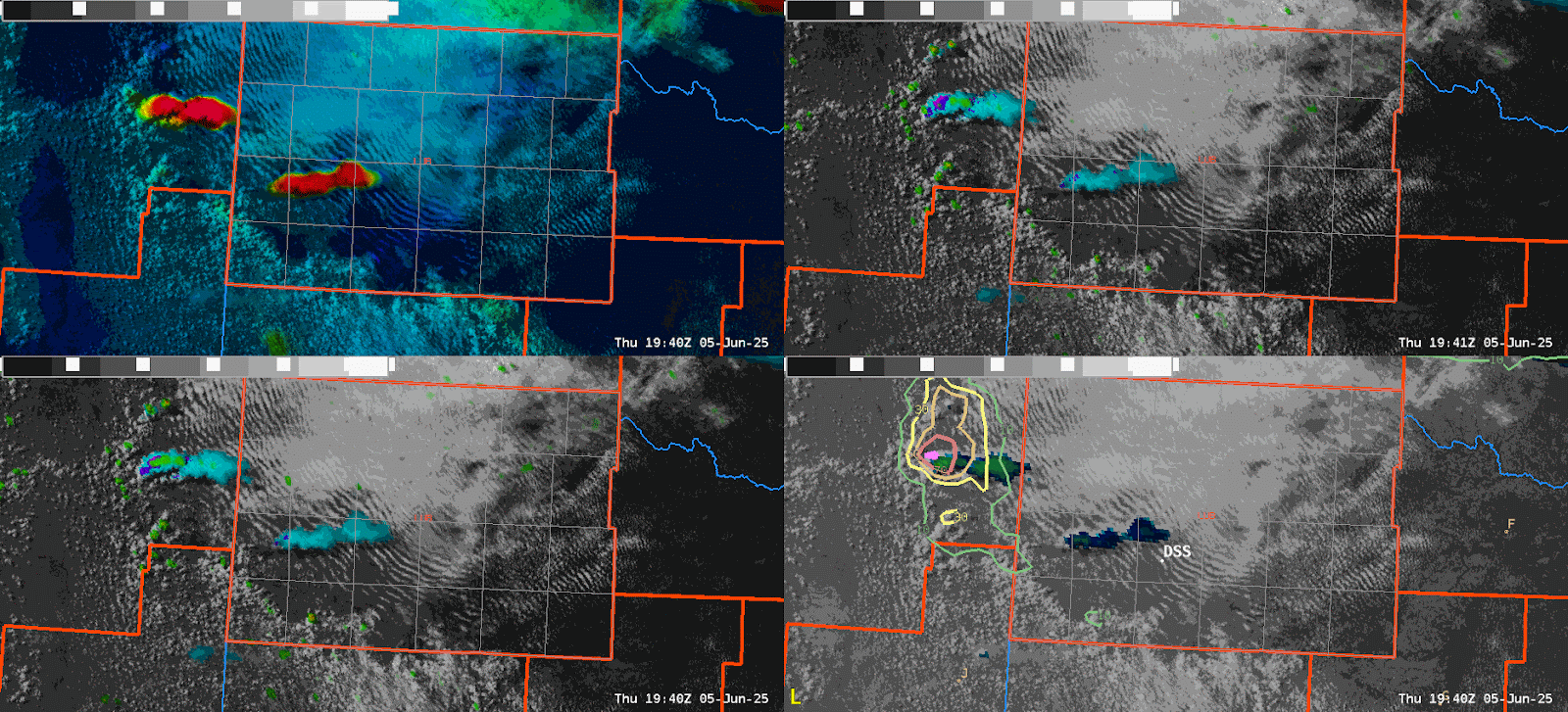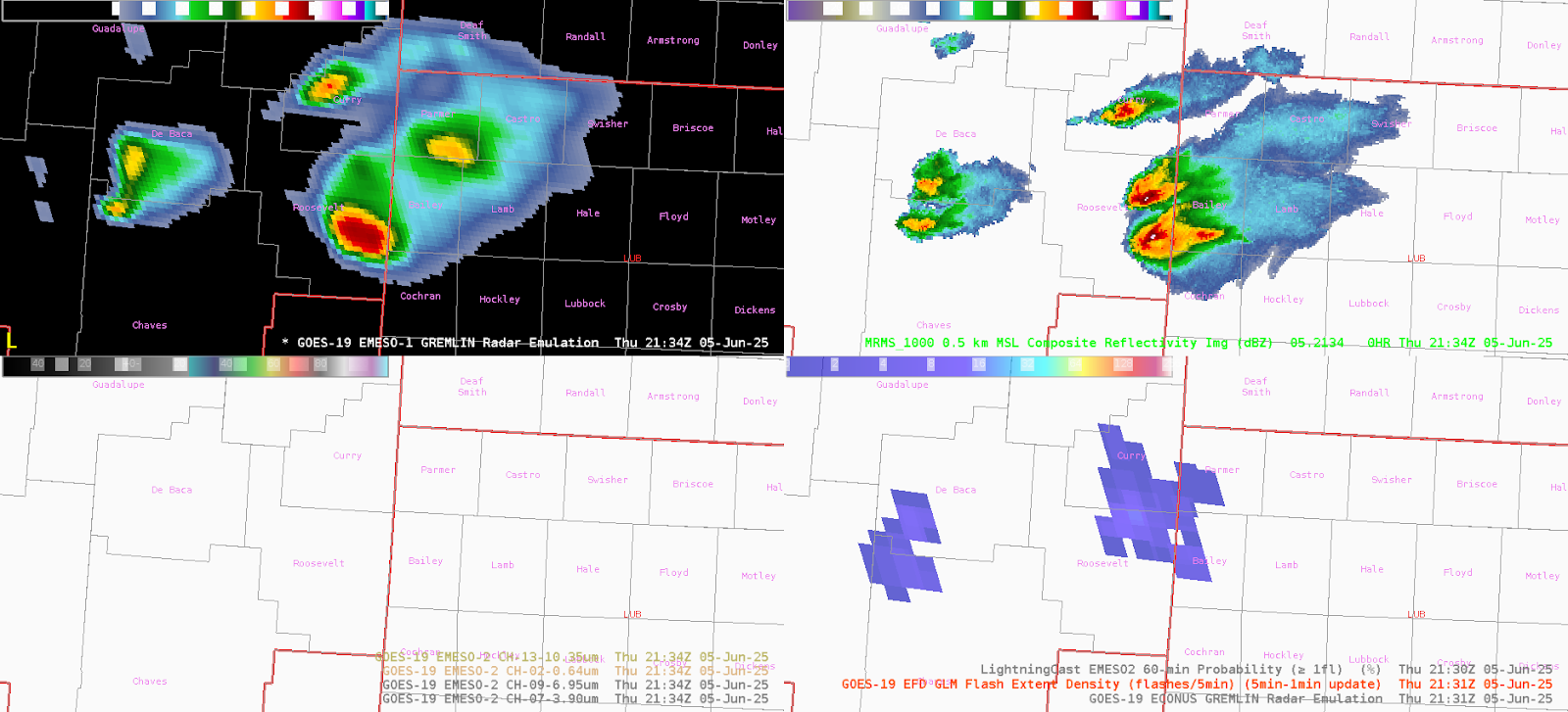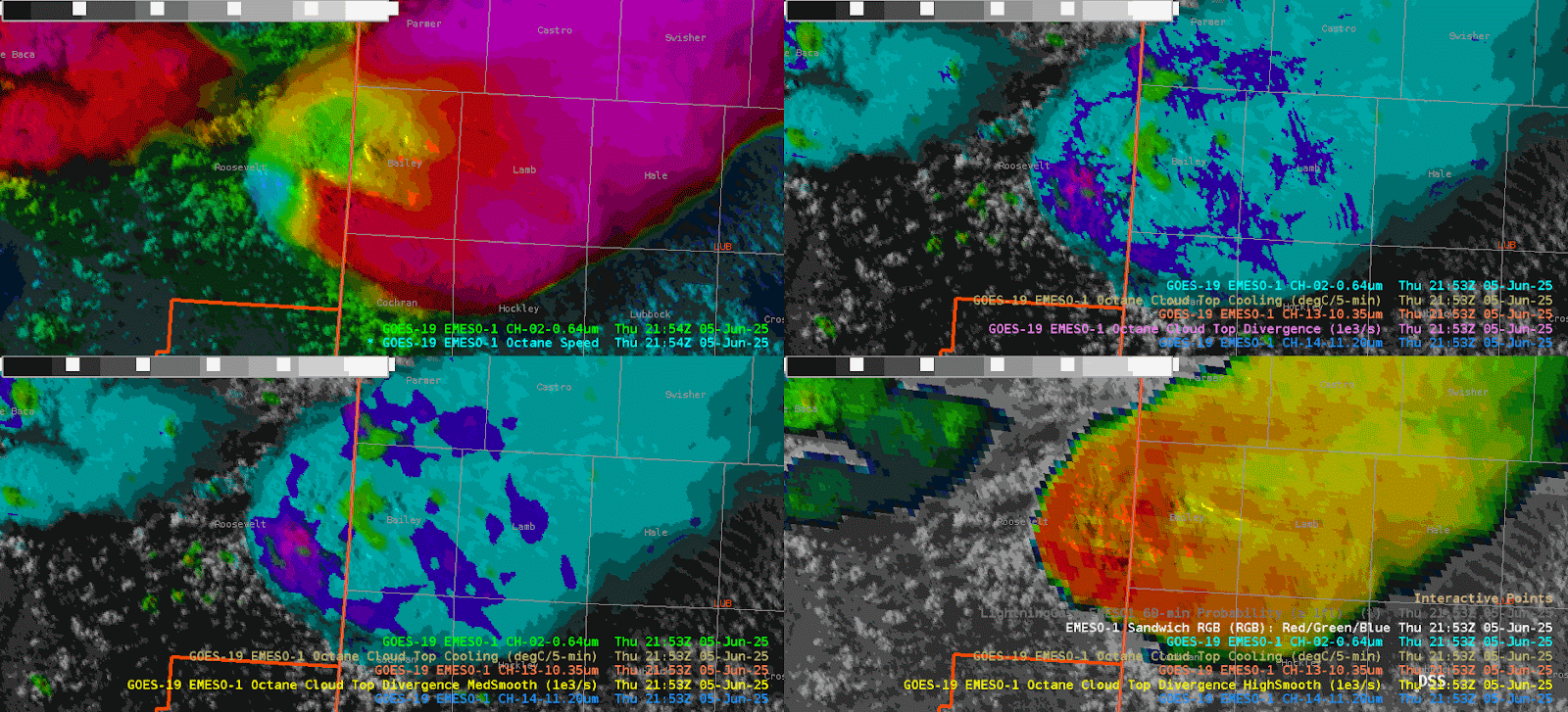SYNOPSIS – A remnant outflow boundary from previous convection was laid out across portions of west Texas. Heating and destabilization occurred along this boundary, setting the stage for scattered supercell development where convergence was maximized. Below are some observations and notes regarding data seen in OCTANE, GREMLIN, and LightningCast.
OPERATIONAL NOTES AND FEEDBACK – Nowcasting Convective Initiation with OCTANE and LightningCast.
As is so often the case in setups like this, there was a fairly large area of towering cumulus clouds and occasional attempts at convective initiation (CI) along the outflow boundary. For today’s operational period, I tried a 4-panel combination that included OCTANE products, LightningCast, and traditional satellite imagery (Figure 1).

Figure 1 – OCTANE Speed (top left); OCTANE Cloud Top Cooling/Divergence-no smoothing (top right); OCTANE Cloud Top Cooling/Divergence-medium smoothing (bottom left); VIS/IR Sandwich + LightningCast (bottom right)
As was seen in previous days of this experiment, OCTANE products helped to identify areas of towering cumulus that had the most vertical growth and, consequently, the greatest near-term potential for CI. This is evidenced by the green shading in both the OCTANE Speed and OCTANE Divergence products in Figure 1. One of the potential enhancements to nowcasting CI is LightningCast. While OCTANE appears to excel at depicting where towing cumulus has the most vertical development, LightningCast appears to excel at pinpointing which of those areas of more developed cumulus have a better chance at producing lightning. This essentially provides additional probabilistic information for trying to determine where CI may soon occur, which trickles down to knowing where to focus pre-CI IDSS.
In Figure 1, for example, an increase in lightning probabilities was observed just west of the WFO Lubbock forecast area, where OCTANE was highlighting increased vertical development of towering cumulus clouds. The increase in probabilities, plus consistently high probabilities, provided lead time on where CI would eventually occur. Note the consistently high probability of lightning in that area, as well as increasing probabilities to the south. Two separate supercells eventually developed in this area, and later went on to produce severe weather.
OPERATIONAL NOTES AND FEEDBACK – Nowcasting Convective Evolution and Intensity with GREMLIN.
For today’s operations, radar coverage was not a challenge, but GREMLIN data was still analyzed to determine if there is utility even in cases where radar coverage is sufficient. Today’s event highlighted several important observations about GREMLIN.
1) This is the first event during this week’s experiment in which 60+ dBZ echoes showed up on GREMLIN. This closely matched the 60+ dBZ cores seen on MRMS (as shown in Figure 2 below). It was noted by the developers that 60+ dBZ echoes offer a high likelihood of severe thunderstorms and this was, indeed, the case in today’s event. This suggests that GREMLIN may offer increased confidence in the occurrence of severe weather regardless of good or poor radar coverage.
Figure 2 – GREMLIN Emulated Reflectivity (top left); MRMS Reflectivity (top right)
2) For sustained, deep convection with cold cloud top temperatures and lightning in the anvil, GREMLIN may sometimes erroneously equate this to precipitation occurring at the surface. Note in Figure 3 below the area of 40+ dBZ echoes depicted by GREMLIN over the northwestern part of the Lubbock CWA. This area corresponds to nearby GLM lightning, but note that no precipitation is depicted by MRMS reflectivity or WSR-88D reflectivity (not shown).
3) When thunderstorms are close together with merging anvils, be aware that GREMLIN may treat this as one thunderstorm, instead of multiple thunderstorms, as seen in Figure 3. Note the one cell seen in GREMLIN data near the far western edge of the Lubbock CWA, then compare that with the two cells that actually existed (as seen in MRMS data). It should be noted, though, that GREMLIN did well to capture the most dominant of the two thunderstorms.

Figure 3 – GREMLIN Emulated Reflectivity (top left); MRMS Reflectivity (top right); GLM Lightning (bottom right)
OPERATIONAL NOTES AND FEEDBACK – Nowcasting Updraft Strength with OCTANE
Today’s event provided an interesting opportunity to nowcast two strong updrafts in close proximity to each other. In Figure 4 below, the OCTANE Speed product reveals a strong updraft developing within the divergent area of a nearby thunderstorm’s updraft. The developers noted that this is impressive because essentially the former updraft is strong enough to oppose the already enhanced, and modified, flow around the latter updraft, suggesting an increased risk of severe weather. The OCTANE Speed product appears to better depict what is happening to the flow aloft around both updrafts when compared to the VIS/IR sandwich product alone. I suggest using OCTANE and the VIS/IR sandwich product in tandem with each other when nowcasting convective updraft evolution.

Figure 4 – OCTANE Speed (top left); OCTANE Cloud Top Cooling/Divergence-no smoothing (top right); OCTANE Cloud Top Cooling/Divergence-medium smoothing (bottom left); VIS/IR Sandwich (bottom right)
– NW Flow


.png)

.png)